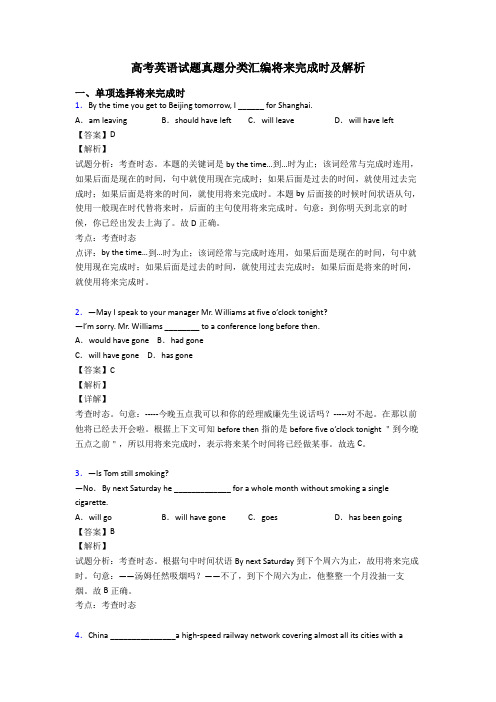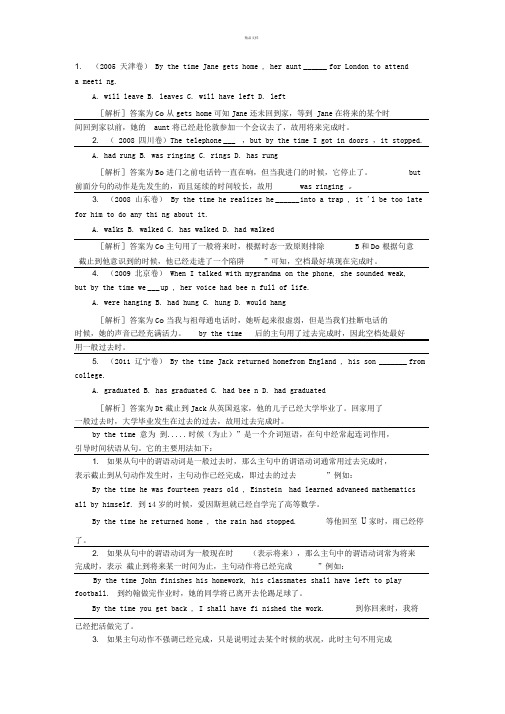从高考题看by the time用法
- 格式:doc
- 大小:25.50 KB
- 文档页数:2

By the time 用法详解•by the time意为“到……时候(为止)”,是一个介词短语,在句中经常起连词作用,引导时间状语从句。
它的主要用法如下:• 1. 如果从句中的谓语动词是一般过去时,那么主句中的谓语动词通常用过去完成时,表示“截止到从句动作发生时,主句动作已经完成,即过去的过去”。
例如:By the time he returned home,the rain had stopped.• By the time I got to the station,the train had already gone。
• 2. 如果从句中的谓语动词为一般现在时/或现在完成时(表示将来),那么主句中的谓语动词常为将来完成时,表示“截止到将来某一时间为止,主句动作将已经完成”。
By the time you get back,I shall have finished the work.• By the time I graduate next year, I will have lived here for 5 years. • By the time of next term , we will have learned 3000 words.• 3. 如果主句动作不强调已经完成,只是说明某个时候的状况,(主句是be的系表形式或者是表示像know, find, believe等表示认知的持续性动词,则往往用一般时态,不用完成时态。
)此时主句不用完成时,而应根据实际需要选用适当的时态,此时by the time相当于when。
例如:• He was out of breath by the time he reached the top.By the time the bus came,so many people were waiting that it was a free fight to get on it. 公共汽车来的时候,等车的人很多,成了一场挤车的混战。


高考英语试题真题分类汇编将来完成时及解析一、单项选择将来完成时1.By the time you get to Beijing tomorrow, I ______ for Shanghai.A.am leaving B.should have left C.will leave D.will have left【答案】D【解析】试题分析:考查时态。
本题的关键词是by the time…到…时为止;该词经常与完成时连用,如果后面是现在的时间,句中就使用现在完成时;如果后面是过去的时间,就使用过去完成时;如果后面是将来的时间,就使用将来完成时。
本题by后面接的时候时间状语从句,使用一般现在时代替将来时,后面的主句使用将来完成时。
句意:到你明天到北京的时候,你已经出发去上海了。
故D正确。
考点:考查时态点评:by the time…到…时为止;该词经常与完成时连用,如果后面是现在的时间,句中就使用现在完成时;如果后面是过去的时间,就使用过去完成时;如果后面是将来的时间,就使用将来完成时。
2.—May I speak to your manager Mr. Williams at five o’clock tonight?—I’m sorry. Mr. Williams ________ to a conference long before then.A.would have gone B.had goneC.will have gone D.has gone【答案】C【解析】【详解】考查时态。
句意:-----今晚五点我可以和你的经理威廉先生说话吗?-----对不起。
在那以前他将已经去开会啦。
根据上下文可知before then指的是before five o’cloc k tonight "到今晚五点之前",所以用将来完成时,表示将来某个时间将已经做某事。
故选C。
3.—Is Tom still smoking?—No.By next Saturday he _____________ for a whole month without smoking a single cigarette.A.will go B.will have gone C.goes D.has been going 【答案】B【解析】试题分析:考查时态。

bythetime的三种用法Bythetime 的三种用法Bythetime 是一个英语短语,用来指代某事在某个时间之前已经发生或完成。
它可以用来描述过去、现在和将来,具有一定的灵活性。
在本文中,我们将详细介绍 Bythetime 的三种常见用法。
1. Bythetime + 过去完成时Bythetime 可以与过去完成时连用,表示在某个过去的时间点之前已经发生或完成的动作。
过去完成时用法为 had + 过去分词。
例如: - Bythetime I arrived home, my mother had already cooked dinner. (在我到家之前,妈妈已经做好了晚饭。
) - Bythetime John woke up, his friends had already left. (约翰醒来时,他的朋友们已经离开了。
)2. Bythetime + 现在完成时Bythetime 也可与现在完成时连用,表示在现在之前已经发生或完成的动作。
现在完成时用法为 have/has + 过去分词。
例如: - Bythetime you finish reading this article, you will have learned a lot.(当你读完这篇文章时,你已经学到了很多。
) - Bythetime we arrive at the cinema, the movie will have started.(当我们到达电影院时,电影已经开始了。
)3. Bythetime + 将来完成时Bythetime 还可以与将来完成时连用,表示到某个将来的时间点之前已经发生或完成的动作。
将来完成时用法为 will have + 过去分词。
例如: - Bythetime you come back, I will have finished my work.(当你回来时,我已经完成了我的工作。

精品文档1. (2005 天津卷) By the time Jane gets home , her aunt ______ for London to attenda meeti ng.A. will leaveB. leavesC. will have leftD. left[解析]答案为C o从gets home可知Jane还未回到家,等到 Jane在将来的某个时间回到家以前,她的aunt将已经赴伦敦参加一个会议去了,故用将来完成时。
2. ( 2008 四川卷)The telephone ___ ,but by the time I got in doors ,it stopped.A. had rungB. was ringingC. ringsD. has rung[解析]答案为B o进门之前电话铃一直在响,但当我进门的时候,它停止了。
but 前面分句的动作是先发生的,而且延续的时间较长,故用was ringing 。
3. (2008 山东卷) By the time he realizes he ______ i nto a trap , it 'l be too late for him to do any thi ng about it.A. walksB. walkedC. has walkedD. had walked[解析]答案为C o主句用了一般将来时,根据时态一致原则排除B和D o根据句意截止到他意识到的时候,他已经走进了一个陷阱”可知,空档最好填现在完成时。
4. (2009 北京卷) When I talked with mygrandma on the phone, she sounded weak,but by the time we ___ up , her voice had bee n full of life.A. were hangingB. had hungC. hungD. would hang[解析]答案为C o当我与祖母通电话时,她听起来很虚弱,但是当我们挂断电话的时候,她的声音已经充满活力。

by the time引导的状语从句【释义】by the time在……时候:表示某个事件发生时的时间点,通常用来描述在某个特定时间之前或之后发生的事情。
【短语】1Carried away by the time随着时间崩溃2By the time the到时间了3By the time their rehabilitation改过时间了4by the time when等到5by the time of到……的时候6when by the time介词7By The Time Iarrived在我到达之前8By The Time This Nig肯尼·基9nevertheless nonetheless by the time到这个时候【例句】1By the time he died,he was a millionaire.到他去世的时候,他已是一位百万富翁。
2By the time we had made landfall the boat looked ten years older!等到我们登陆时,这艘船看似已老了10年!3By the time this gets into print,they'll already have left the country.这篇东西发表的时候,他们将已经离开这个国家了。
4By the time our officers arrived,the dead and the dying were everywhere.当我们的警官到达的时候已是遍地尸首和垂死的人。
5By the time he was sixteen,Malcolm already knew most of the city's teenage hangouts.马尔科姆16岁的时候已经知道了城里青少年常去的大多数地方。
6By the time I was vice chancellor,the Senate had become a much larger and a much more democratic body.到我做副校长的那个时候,大学评议会已经成为一个更大、更民主的机构了。
“by+时间”的时态“by+时间”意为“不迟于(=not later than)”;“一到(=as soon as)”;“当某时候到了[=when (the time indicated) comes]”;“到…时为止”等。
时间上有过去、现在和将来之别。
主动词本身有动作与状态之分,其时态可为一般式、完成式、进行式或完成进行式。
现分述如下:1.“by+时间”与动作性强的动词连用时,主句多用于完成式。
by 后的时间可指现在、过去或将来时间点。
如: By the time he was fourteen years old, he had learned maths all by himself. 到14岁的时候,他就已经自学了数学[SB 2B p.2]。
I shall have finished it by the time you come back.你回来以前我就把它做完了[1]。
By the end of the match, they had kicked two goals and we had kicked four. [JB p91] 比赛结束时,他们踢进了2分我们踢了4分。
They must have finished their work by this time.他们现在一定已经完成工作了[2]。
但是,上述情况中当时间为将来时,主句动作发生在从句动作之后时,主句动词可用一般时态。
如:If you're not better by then, I'll take you to see the doctor. [JB3 p.85] 如果到那时还不好些,我就带你去看病。
Can you finish this by tomorrow? 在明天以前你能做完这件事吗[1]?间或有用进行式的。
如:By the end of the first week the head of the department was saying very nice things ab out me. 第一周末时系主任给我多多美言了几句 [3]。
bythetimeof的用法
"by the time of"的用法是指在某个特定的时间点之前。
它常常用来描述两个事件之间的时间关系或某个事件在特定时间点之前的状态。
以下是一些例句:
1. By the time of his retirement, he had worked for the company for 30 years.
(在他退休的时候,他在这家公司已经工作了30年。
)
2. By the time of the meeting, I had already finished my presentation. (在会议开始之前,我已经完成了我的演讲。
)
3. By the time of the concert, all the tickets had been sold out.
(到音乐会开始的时候,所有的门票已经卖光了。
)
4. By the time of the wedding, the bride had already chosen her wedding dress.
(到婚礼的时候,新娘已经选好了她的婚纱。
)
5. By the time of his graduation, he had completed his thesis.
(在他毕业的时候,他已经完成了自己的论文。
)
需要注意的是,"by the time of"强调的是某一特定时间点之前的事情发生或完成。
by the time引导的时间状语从句时态规则“Bythetime”是英语中的一个常见短语,用来表示某个动作或事件发生时,另一个动作或事件已经完成或正在进行。
在句子中,它常常用来引导时间状语从句,表示时间先后顺序。
在使用“by the time”引导的时间状语从句时,我们需要注意时态的使用规则。
具体来说,有以下几点:1. 如果主句是一般现在时,则从句需要使用一般过去时。
例如:- By the time I get home, my mom has already cooked dinner. (主句为一般现在时,从句使用一般过去时)2. 如果主句是一般过去时,则从句需要使用过去完成时。
例如:- By the time I arrived at the party, everyone had already left. (主句为一般过去时,从句使用过去完成时)3. 如果主句是将来时,则从句需要使用将来完成时。
例如:- By the time you come back, I will have finished my work. (主句为将来时,从句使用将来完成时)需要注意的是,如果从句中有表示持续性动作的动词,我们需要使用完成进行时。
例如:- By the time I finish school, I will have been studyingfor 12 years. (从句中的动词“studying”表示持续性动作,因此使用完成进行时)总之,使用“by the time”引导的时间状语从句时,我们需要根据主句的时态来确定从句的时态。
在实际运用中,需要注意不同时态之间的转换和正确使用。
2024届高考英语二轮复习2017年-2023-2024年高考英语阅读真题长难句解析(223-224)讲义- 长难句翻译By the time 250,000 were on the bridge, engineers noticed something terrible: the roadway was flattening under what turned out to be the heaviest load it had ever been asked to carry.Readers will encounter not only stories they have heard before, but some new stories and a moving discussion of the responsibility of the engineer to the public and the ways young engineers can be helped to grasp them.长难句翻译解析By the time 250,000 were on the bridge, engineers noticed something terrible: the roadway was flattening under what turned out to be the heaviest load it had ever been asked to carry.【阅读逻辑拓展:用一个句子告诉您如何在阅读文章时快速分析句子】①内容分析今天的句子挺有意思,能够非常清晰地体现阅读理解该怎么阅读,又该怎么理解。
冒号把句子分成前后两部分,前一部分特别简单,后一部分特别复杂。
By the time 250,000 were on the bridge, engineers noticed something terrible前半句重点词只有一个:terrible。
1. (2005天津卷)By the time Jane gets home,her aunt_____for London to attend a meeting.
A. will leave
B. leaves
C. will have left
D. left
[解析]答案为C。
从gets home可知Jane还未回到家,等到Jane在将来的某个时间回到家以前,她的aunt将已经赴伦敦参加一个会议去了,故用将来完成时。
2. (2008四川卷)The telephone_____,but by the time I got indoors,it stopped.
A. had rung
B. was ringing
C. rings
D. has rung
[解析]答案为B。
进门之前电话铃一直在响,但当我进门的时候,它停止了。
but 前面分句的动作是先发生的,而且延续的时间较长,故用was ringing。
3. (2008山东卷)By the time he realizes he_____into a trap,it’ll be too la te for him to do anything about it.
A. walks
B. walked
C. has walked
D. had walked
[解析]答案为C。
主句用了一般将来时,根据时态一致原则排除B和D。
根据句意“截止到他意识到的时候,他已经走进了一个陷阱”可知,空档最好填现在完成时。
4. (2009北京卷)When I talked with my grandma on the phone,she sounded weak,but by the time we_____up,her voice had been full of life.
A. were hanging
B. had hung
C. hung
D. would hang
[解析]答案为C。
当我与祖母通电话时,她听起来很虚弱,但是当我们挂断电话的时候,她的声音已经充满活力。
by the time后的主句用了过去完成时,因此空档处最好用一般过去时。
5. (2011辽宁卷)By the time Jack returned home from England,his son_____from college.
A. graduated
B. has graduated
C. had been
D. had graduated
[解析]答案为D。
截止到Jack从英国返家,他的儿子已经大学毕业了。
回家用了一般过去时,大学毕业发生在过去的过去,故用过去完成时。
by the time意为“到……时候(为止)”,是一个介词短语,在句中经常起连词作用,引导时间状语从句。
它的主要用法如下:
1. 如果从句中的谓语动词是一般过去时,那么主句中的谓语动词通常用过去完成时,表示“截止到从句动作发生时,主句动作已经完成,即过去的过去”。
例如:By the time he was fourteen years old,Einstein had learned advanced mathematics all by himself. 到14岁的时候,爱因斯坦就已经自学完了高等数学。
By the time he returned home,the rain had stopped. 等他回到家时,雨已经停了。
2. 如果从句中的谓语动词为一般现在时(表示将来),那么主句中的谓语动词常为将来完成时,表示“截止到将来某一时间为止,主句动作将已经完成”。
例如:
By the time John finishes his homework,his classmates shall have left to play football. 到约翰做完作业时,她的同学将已离开去伦踢足球了。
By the time you get back,I shall have finished the work. 到你回来时,我将已经把活做完了。
3. 如果主句动作不强调已经完成,只是说明过去某个时候的状况,此时主句不用完成时,而应根据实际需要选用适当的时态,此时by the time相当于when。
例如:He was out of breath by the time he reached the top. 登上顶端时,他气喘吁吁。
By the time the bus came,so many people were waiting that it was a free fight to get on it. 公共汽车来的时候,等车的人很多,成了一场挤车的混战。
[能力拓展训练]
1. By the time you arrive home,I_____,so please don’t make any noise when you come in.
A. shall have been sleeping
B. shall have slept
C. shall sleep
D. shall be sleeping
2. By the time you arrive in London,we_____in Europe for two weeks.
A. shall stay
B. have stayed
C. will have stayed
D. have been staying
3. Hurry up!By the time we get to the church,the marriage service_____.
A. had started
B. will have started
C. has started
D. must have started
4. ―Did you see Xiao Li at the party?
―No,_____by the time I arrived
A. she’d left
B. she’s left
C. she was left
D. she must leave
5. By the time I saw the angry expression on his face,I_____what I had to face.
A. knew
B. have known
C. would know
D. had known
Key:1-5 DCBAA。